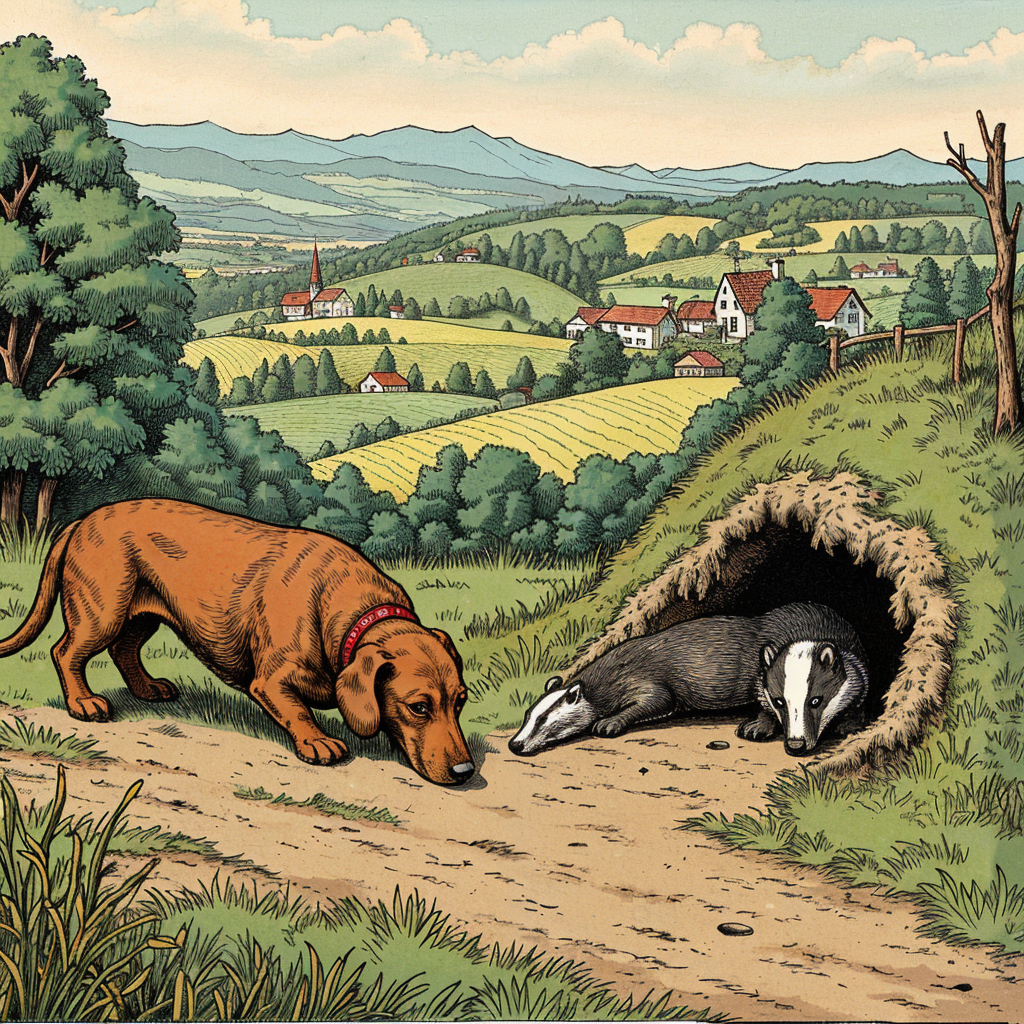Ethical dachshund breeding is a topic that many pet lovers find both interesting and essential. The goal is to ensure that breeding practices lead to healthy, happy puppies and a better overall breed. In this article, I check out what ethical breeding for dachshunds means and why it plays such a very important role in producing healthy litters.

Understanding Ethical Dachshund Breeding
When discussing ethical breeding practices, it is important to consider both the physical and emotional well‐being of the dogs involved. Ethical breeders focus on ensuring that each puppy is raised in a healthy environment free from inbreeding, genetic disorders, and poor living conditions. These breeders place an emphasis on care throughout the entire process, from conception to adoption.
Ethical breeding takes a holistic approach that includes genetic testing, proper socialization, and ongoing health checks. This attention to detail helps prevent hereditary illnesses or behavioral problems from spreading. By choosing responsible breeding, buyers can be more confident in the quality and longevity of the puppy they bring home.
It is equally important for prospective buyers to understand the rationale behind ethical breeding practices. Beyond the immediate health benefits for the puppies, ethical breeding contributes to the long‐term viability of the breed and preserves important characteristics, such as a loving temperament and physical soundness. This care ensures that dachshunds remain a beloved companion breed for years to come.
Foundations of Ethical Breeding Practices
Before jumping into the methods and benefits of ethical breeding, it is important to lay the groundwork by understanding what constitutes a responsible breeder. Ethical breeders conduct thorough research and follow well-documented practices. Several key factors include:
- Genetic Testing: Ensuring that potential parents are screened for hereditary issues.
- Health and Temperament Evaluations: Assessing both physical and behavioral traits to guarantee a balanced trait transfer to the puppies.
- Environmental Standards: Providing a clean, nurturing environment where both the dam and the puppies thrive.
These central pillars not only secure the immediate health of the puppies but also contribute to the overall improvement of the breed. Responsible breeders are committed to the idea that healthy puppies come from healthy parents, and good environments make a world of difference during a puppy’s critical early stages of development.
A Quick Guide to Ensuring Healthy Puppies
For those just getting interested in ethical breeding, understanding the process can seem overwhelming. To help simplify the complex world of puppy breeding, here is a step-by-step guide that outlines the most important actions:
- Selecting the Right Parents: Choose breeding pairs that have been thoroughly vetted for genetic and hereditary conditions. Responsible breeders look for parents with compatible temperaments and proven health records.
- Prioritizing Health Screenings: All-in-one health evaluations, including genetic tests and veterinarian reviews, are a must. These screenings help detect issues before they can affect the puppies.
- Creating a Nurturing Environment: Provide spacious, clean living conditions along with proper nutrition and socialization opportunities. A harmonious environment during the early growth stages leads to better-stabilized behavior later in life.
- Continuous Monitoring: Ethical breeders keep in regular contact with new owners and offer guidance to ensure that the puppies continue to receive proper care after adoption.
- Transparent Communication: Maintaining open dialogue with prospective owners about the breeding process, potential health issues, and the responsibilities of dog ownership builds trust. It is not just about the breeding process. It is about building a long-lasting relationship between breeder and pet owner.
Following these steps can make a significant difference in the overall health and temperament of the puppies. For both breeders and new pet owners, this transparency is key to forming a lasting relationship with the pet and for contributing to the integrity of the dachshund breed.
Common Concerns in Ethical Breeding
Like any process, ethical breeding has its challenges; however, many issues can be eased up with careful planning and genuine care. Common concerns in ethical breeding include:
- Genetic Health: Avoiding inbreeding and closely related pairings is important to reduce the risk of genetic diseases.
- Puppy Socialization: Puppies must be adequately socialized to appear confident and friendly. Adequate socialization routines should begin early on, ensuring the pups are well-rounded individuals as they grow.
- Proper Environment: A business that focuses on profit over welfare may neglect the environmental needs of the dam and puppies. Ethical breeders invest in superior living conditions to promote natural growth and development.
- Regulatory Compliance: Adhering to local and national animal welfare laws is not optional for ethical breeders. These regulations guide the appropriate care, licensing, and oversight of breeding practices.
Genetic Health
The health of a dachshund is largely determined by the genetics passed down from its parents. Ethical breeders screen potential breeding pairs for common hereditary conditions such as intervertebral disc disease, which dachshunds can be prone to. By taking a proactive approach, breeders can lower the chance that these problems will manifest in the puppies, leading to a healthier and more robust litter.
Puppy Socialization
Early socialization is a cornerstone of responsible breeding. A puppy’s environment during the first few weeks is critical. Ethical breeders expose their puppies to a variety of safe experiences, sounds, and gentle handling to help reduce anxiety later in life. Consistent social interaction means that puppies are better prepared to interact with both other dogs and people once they leave the nursery.
Maintaining a Responsible Breeding Environment
A safe and clean environment is more than just a nice-to-have in breeding; it is essential for the well-being of the animals. Responsible breeders create spaces that promote physical activity, mental stimulation, and overall comfort. Areas for play and rest are designed to stimulate natural behaviors while reducing stress and the likelihood of disease transmission.
Following Legal Guidelines
Ethical breeding practices go hand-in-hand with regulatory compliance. Keeping up with licensing requirements, animal welfare standards, and regular veterinary check-ups is non-negotiable. By following local and national laws, ethical breeders contribute to the wider community of responsible pet ownership and help prevent illegal or exploitative breeding practices.
It is worth noting that these focus areas are not isolated. They work together to ensure that each puppy is given every advantage for a healthy start in life. The more transparent breeders are regarding their practices, the more confidence prospective owners can gain in the process.
Advanced Insights on Ethical Breeding
Once the basics of ethical breeding are understood, there are advanced tips that can further take up a notch the quality of the puppies and improve the overall breeding program. For example, many breeders now focus on long-term follow-ups, engaging with new puppy owners long after adoption. This helps to monitor the puppy’s development and detect any emerging health or behavioral issues early on.
Focus on Nutrition and Early Veterinary Care: Special diets and early health check-ups can make a significant difference in a young dachshund’s development. Feeding high-quality, balanced meals and scheduling initial veterinary visits set up the pup for a healthy life.
Structured Socialization Programs: Creating a structured plan for early socialization helps puppies adapt to new surroundings. This can include controlled exposure to different sounds, environments, and other animals.
Record-Keeping and Data Analysis: Many advanced ethical breeders keep detailed records of their breeding pairs, health tests, and growth milestones of puppies. This data can help identify trends over time and inform future breeding decisions to continually improve the program.
Watching trends and drawing insights from recorded data is a great way to get a feel for whether the methods being employed are effective. This ongoing commitment to improvement is something that sets truly ethical breeders apart from those who view breeding simply as a means to an end.
Key Factors in Promoting Healthy Puppy Development
Healthy puppy development is influenced by many factors, but there are some core components that every responsible breeder should consider. These include genetic selection, environmental conditions, and continuous care. When these factors are managed well, puppies often grow to be strong and well-adjusted members of their families.
Choosing a mate that is not only physically healthy but also exhibits the right temperament is an important aspect of ethical breeding. This careful selection process reduces the risk of hereditary and behavioral issues. In addition, keeping parents in a nurturing environment with proper exercise and mental stimulation means that the puppies have an optimal start in life.
The positive outcomes of ethical breeding extend past the individual animal to impact the entire breed. Ethical breeding preserves essential traits such as loyalty, playfulness, and affectionate behavior that are highly valued by dachshund enthusiasts. With every well-cared-for litter, the overall reputation and health of the breed continue to improve.
- Genetic Selection: Careful consideration of genetic factors minimizes health issues and leads to robust puppies.
- Nurturing Environment: A stable and loving environment supports better physical and mental growth.
- Ongoing Health Monitoring: Consistent veterinary care and follow-up ensure any potential issues are addressed early on.
All of these practices contribute to a breeding program where the health of the puppies is the top priority. The benefits of ethical breeding practices extend far beyond the litter; they pave the way for a healthier future for the dachshund breed as a whole.
Additional Considerations for Ethical Dachshund Breeding
To further give a boost to the conversation around ethical dachshund breeding, it is important to consider additional factors that may not be immediately evident. Many breeders are now devoting extra time to understanding the subtle behavioral cues of their dogs and adjusting practices accordingly. This extra effort can make all the difference. Owners and breeders alike benefit when there is ongoing support and open dialogue long after the adoption process has been completed.
One area that has seen a next stage improvement is the integration of modern technology in breeding practices. Using digital record-keeping and scheduled reminders for health check-ups, breeders can keep a sharp eye on the development of each puppy. These innovations not only make the process smoother but also help in tracking long-term outcomes. In many cases, new research findings and genetic advancements are shared among breeders in informal groups, where ideas are exchanged to further improve practices.
Furthermore, community outreach and educational seminars are becoming a common approach among ethical breeders. These initiatives allow potential pet owners to ask questions and get involved in discussions about best practices for dog care. By hosting workshops and open house events, breeders show that ethical breeding is not merely a business—it is a commitment to nurturing a legacy of well-cared-for animals.
This additional focus on modern techniques and community involvement not only reinforces the ethical standards but also offers a platform for continual learning. Responsible breeders who invest in ongoing education and outreach contribute to a more informed public. Ultimately, this ensures the long-term stability and improvement of the dachshund breed, allowing future generations to benefit from today’s efforts.
Frequently Asked Questions
Here are some common questions people have about ethical dachshund breeding:
Question: What does ethical breeding mean for dachshunds?
Answer: It means breeding in a way that prioritizes the health, temperament, and well-being of both the parents and the puppies. Ethical breeding includes genetic testing, proper care, and continuous health monitoring.
Question: How can I tell if a breeder is practicing ethical breeding?
Answer: Look for breeders who are transparent about their practices. They should provide full health histories, details about genetic tests, and clear information about the environment in which the puppies are raised.
Question: Why is genetic testing important in breeding dachshunds?
Answer: Genetic testing helps identify potential health risks that can be passed on to puppies. By ensuring that both parents are free from known genetic disorders, ethical breeders promote healthier outcomes for the offspring.
Question: What role does socialization play in ethical breeding?
Answer: Socialization at an early age helps puppies grow into more confident and well-adjusted adults. Responsible breeders introduce puppies to various stimuli in controlled settings, ensuring they are prepared for life in a family environment.
Conclusion
Ethical dachshund breeding is about more than just producing puppies. It ensures that every little dog has the best start in life possible. By following practices that emphasize genetic health, proper socialization, and excellent living conditions, breeders help form a more robust and reputable breed.
For those considering adding a dachshund to their family, it is very important to do research and connect with breeders who take their responsibility seriously. Not only does this approach lead to healthier puppies, but it also supports the future of the breed as a whole.
Wrapping up, embracing ethical breeding practices involves commitment, continuous learning, and genuine compassion. When breeders keep the well-being of their dogs as the top priority, they lay the foundation for generations of happy, healthy dachshunds. Choosing a companion from such a program means you are investing in more than just a pet. It means you are contributing to a legacy of care and responsible breeding that will benefit dogs and their families for many years to come.







